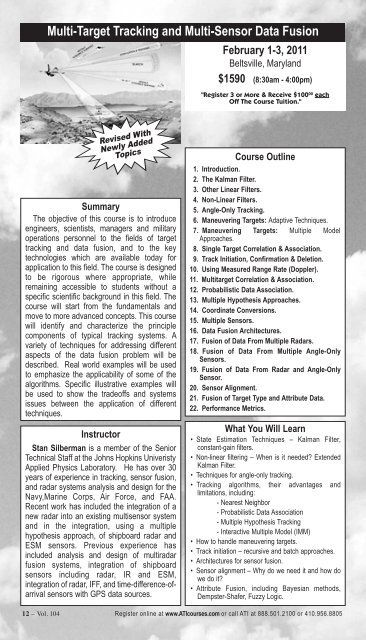Systems Engineering - ATI
Systems Engineering - ATI
Systems Engineering - ATI
Create successful ePaper yourself
Turn your PDF publications into a flip-book with our unique Google optimized e-Paper software.
Multi-Target Tracking and Multi-Sensor Data Fusion<br />
February 1-3, 2011<br />
Beltsville, Maryland<br />
$1590 (8:30am - 4:00pm)<br />
"Register 3 or More & Receive $100 00 each<br />
Off The Course Tuition."<br />
Instructor<br />
Revised With<br />
Newly Added<br />
Topics<br />
Summary<br />
The objective of this course is to introduce<br />
engineers, scientists, managers and military<br />
operations personnel to the fields of target<br />
tracking and data fusion, and to the key<br />
technologies which are available today for<br />
application to this field. The course is designed<br />
to be rigorous where appropriate, while<br />
remaining accessible to students without a<br />
specific scientific background in this field. The<br />
course will start from the fundamentals and<br />
move to more advanced concepts. This course<br />
will identify and characterize the principle<br />
components of typical tracking systems. A<br />
variety of techniques for addressing different<br />
aspects of the data fusion problem will be<br />
described. Real world examples will be used<br />
to emphasize the applicability of some of the<br />
algorithms. Specific illustrative examples will<br />
be used to show the tradeoffs and systems<br />
issues between the application of different<br />
techniques.<br />
Stan Silberman is a member of the Senior<br />
Technical Staff at the Johns Hopkins Univeristy<br />
Applied Physics Laboratory. He has over 30<br />
years of experience in tracking, sensor fusion,<br />
and radar systems analysis and design for the<br />
Navy,Marine Corps, Air Force, and FAA.<br />
Recent work has included the integration of a<br />
new radar into an existing multisensor system<br />
and in the integration, using a multiple<br />
hypothesis approach, of shipboard radar and<br />
ESM sensors. Previous experience has<br />
included analysis and design of multiradar<br />
fusion systems, integration of shipboard<br />
sensors including radar, IR and ESM,<br />
integration of radar, IFF, and time-difference-ofarrival<br />
sensors with GPS data sources.<br />
Course Outline<br />
1. Introduction.<br />
2. The Kalman Filter.<br />
3. Other Linear Filters.<br />
4. Non-Linear Filters.<br />
5. Angle-Only Tracking.<br />
6. Maneuvering Targets: Adaptive Techniques.<br />
7. Maneuvering Targets: Multiple Model<br />
Approaches.<br />
8. Single Target Correlation & Association.<br />
9. Track Initiation, Confirmation & Deletion.<br />
10. Using Measured Range Rate (Doppler).<br />
11. Multitarget Correlation & Association.<br />
12. Probabilistic Data Association.<br />
13. Multiple Hypothesis Approaches.<br />
14. Coordinate Conversions.<br />
15. Multiple Sensors.<br />
16. Data Fusion Architectures.<br />
17. Fusion of Data From Multiple Radars.<br />
18. Fusion of Data From Multiple Angle-Only<br />
Sensors.<br />
19. Fusion of Data From Radar and Angle-Only<br />
Sensor.<br />
20. Sensor Alignment.<br />
21. Fusion of Target Type and Attribute Data.<br />
22. Performance Metrics.<br />
What You Will Learn<br />
• State Estimation Techniques – Kalman Filter,<br />
constant-gain filters.<br />
• Non-linear filtering – When is it needed Extended<br />
Kalman Filter.<br />
• Techniques for angle-only tracking.<br />
• Tracking algorithms, their advantages and<br />
limitations, including:<br />
- Nearest Neighbor<br />
- Probabilistic Data Association<br />
- Multiple Hypothesis Tracking<br />
- Interactive Multiple Model (IMM)<br />
• How to handle maneuvering targets.<br />
• Track initiation – recursive and batch approaches.<br />
• Architectures for sensor fusion.<br />
• Sensor alignment – Why do we need it and how do<br />
we do it<br />
• Attribute Fusion, including Bayesian methods,<br />
Dempster-Shafer, Fuzzy Logic.<br />
12 – Vol. 104 Register online at www.<strong>ATI</strong>courses.com or call <strong>ATI</strong> at 888.501.2100 or 410.956.8805

















